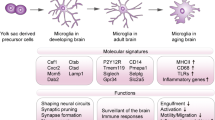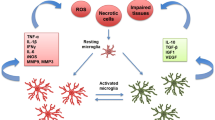Abstract
The brain is comprised of neurons and its support system including astrocytes, glial cells and microglia, thereby forming neurovascular units. Neurons require support from glial cells to establish and maintain functional circuits, but microglia are often overlooked. Microglia function as the immune cell of the central nervous system, acting to monitor the microenvironment for changes in signaling, pathogens and injury. More recently, other functional roles for microglia within the healthy brain have been identified, including regulating synapse formation, elimination and function. This review aims to highlight and discuss these alternate microglial roles in the healthy and in contrast, diseased brain with a focus on two acute neurological diseases, traumatic brain injury and epilepsy. In these conditions, microglial roles in synaptic stripping and stabilization as part of neuronal:glial interactions may position them as mediators of the transition between injury-induced circuit dismantling and subsequent reorganization. Increased understanding of microglia roles could identify therapeutic targets to mitigate the consequences of neurological disease.

Similar content being viewed by others
References
Adalbert R, Gilley J, Coleman MP (2007) Abeta, tau and ApoE4 in Alzheimer’s disease: the axonal connection. Trends Mol Med 13(4):135–142
Ajami B et al (2007) Local self-renewal can sustain CNS microglia maintenance and function throughout adult life. Nat Neurosci 10(12):1538–1543
Annunziato L, Boscia F, Pignataro G (2013) Ionic transporter activity in astrocytes, microglia, and oligodendrocytes during brain ischemia. J Cereb Blood Flow Metab 33(7):969–982
Araque A et al (1999) Tripartite synapses: glia, the unacknowledged partner. Trends Neurosci 22(5):208–215
Barclay AN et al (2002) CD200 and membrane protein interactions in the control of myeloid cells. Trends Immunol 23(6):285–290
Benarroch EE (2013) Microglia: multiple roles in surveillance, circuit shaping, and response to injury. Neurology 81(12):1079–1088
Beumer W et al (2012) The immune theory of psychiatric diseases: a key role for activated microglia and circulating monocytes. J Leukoc Biol 92(5):959–975
Biber K et al (2006) Chemokines and their receptors in central nervous system disease. Curr Drug Targets 7(1):29–46
Biber K et al (2007) Neuronal ‘On’ and ‘Off’ signals control microglia. Trends Neurosci 30(11):596–602
Blank T, Prinz M (2013) Microglia as modulators of cognition and neuropsychiatric disorders. Glia 61(1):62–70
Blinzinger K, Kreutzberg G (1968) Displacement of synaptic terminals from regenerating motoneurons by microglial cells. Z Zellforsch Mikrosk Anat 85(2):145–157
Block ML, Zecca L, Hong JS (2007) Microglia-mediated neurotoxicity: uncovering the molecular mechanisms. Nat Rev Neurosci 8(1):57–69
Boer K et al (2006) Evidence of activated microglia in focal cortical dysplasia. J Neuroimmunol 173(1–2):188–195
Brockhaus J, Moller T, Kettenmann H (1996) Phagocytozing ameboid microglial cells studied in a mouse corpus callosum slice preparation. Glia 16(1):81–90
Burda JE, Sofroniew MV (2014) Reactive gliosis and the multicellular response to CNS damage and disease. Neuron 81(2):229–248
Cao T et al (2012) Morphological and genetic activation of microglia after diffuse traumatic brain injury in the rat. Neuroscience 225:65–75
Cardona AE et al (2006) Control of microglial neurotoxicity by the fractalkine receptor. Nat Neurosci 9(7):917–924
Carthew HL, Ziebell JM, Vink R (2012) Substance P-induced changes in cell genesis following diffuse traumatic brain injury. Neuroscience 214:78–83
Chen SK et al (2010) Hematopoietic origin of pathological grooming in Hoxb8 mutant mice. Cell 141(5):775–785
Davalos D et al (2005) ATP mediates rapid microglial response to local brain injury in vivo. Nat Neurosci 8(6):752–758
Derecki NC et al (2012) Wild-type microglia arrest pathology in a mouse model of Rett syndrome. Nature 484(7392):105–109
Dityatev A, Rusakov DA (2011) Molecular signals of plasticity at the tetrapartite synapse. Curr Opin Neurobiol 21(2):353–359
Drexel M, Preidt AP, Sperk G (2012) Sequel of spontaneous seizures after kainic acid-induced status epilepticus and associated neuropathological changes in the subiculum and entorhinal cortex. Neuropharmacology 63(5):806–817
Frick LR, Williams K, Pittenger C (2013) Microglial dysregulation in psychiatric disease. Clin Dev Immunol 2013:608654
Goldberg EM, Coulter DA (2013) Mechanisms of epileptogenesis: a convergence on neural circuit dysfunction. Nat Rev Neurosci 14(5):337–349
Graeber MB (2010) Changing face of microglia. Science 330(6005):783–788
Greer JM, Capecchi MR (2002) Hoxb8 is required for normal grooming behavior in mice. Neuron 33(1):23–34
Hailer NP, Jarhult JD, Nitsch R (1996) Resting microglial cells in vitro: analysis of morphology and adhesion molecule expression in organotypic hippocampal slice cultures. Glia 18(4):319–331
Hailer NP et al (1997) Fluorescent dye prelabelled microglial cells migrate into organotypic hippocampal slice cultures and ramify. Eur J Neurosci 9(4):863–866
Hall KD, Lifshitz J (2010) Diffuse traumatic brain injury initially attenuates and later expands activation of the rat somatosensory whisker circuit concomitant with neuroplastic responses. Brain Res 1323:161–173
Hanisch UK, Kettenmann H (2007) Microglia: active sensor and versatile effector cells in the normal and pathologic brain. Nat Neurosci 10(11):1387–1394
Haydon PG (2001) GLIA: listening and talking to the synapse. Nat Rev Neurosci 2(3):185–193
Hoek RM et al (2000) Down-regulation of the macrophage lineage through interaction with OX2 (CD200). Science 290(5497):1768–1771
Kalla R et al (2001) Microglia and the early phase of immune surveillance in the axotomized facial motor nucleus: impaired microglial activation and lymphocyte recruitment but no effect on neuronal survival or axonal regeneration in macrophage-colony stimulating factor-deficient mice. J Comp Neurol 436(2):182–201
Kelley BJ et al (2006) Traumatic axonal injury in the perisomatic domain triggers ultrarapid secondary axotomy and Wallerian degeneration. Exp Neurol 198(2):350–360
Kettenmann H, Kirchhoff F, Verkhratsky A (2013) Microglia: new roles for the synaptic stripper. Neuron 77(1):10–18
Kreutzberg GW (1996) Microglia: a sensor for pathological events in the CNS. Trends Neurosci 19(8):312–318
Ladeby R et al (2005) Microglial cell population dynamics in the injured adult central nervous system. Brain Res Brain Res Rev 48(2):196–206
Lazar G, Pal E (1996) Removal of cobalt-labeled neurons and nerve fibers by microglia from the frog’s brain and spinal cord. Glia 16(2):101–107
Learoyd AE, Lifshitz J (2012) Comparison of rat sensory behavioral tasks to detect somatosensory morbidity after diffuse brain-injury. Behav Brain Res 226(1):197–204
Lifshitz J, Lisembee AM (2012) Neurodegeneration in the somatosensory cortex after experimental diffuse brain injury. Brain Struct Funct 217(1):49–61
Lifshitz J, Kelley BJ, Povlishock JT (2007) Perisomatic thalamic axotomy after diffuse traumatic brain injury is associated with atrophy rather than cell death. J Neuropathol Exp Neurol 66(3):218–229
McNamara KC, Lisembee AM, Lifshitz J (2010) The whisker nuisance task identifies a late-onset, persistent sensory sensitivity in diffuse brain-injured rats. J Neurotrauma 27(4):695–706
Mizuno T et al (2003) Production and neuroprotective functions of fractalkine in the central nervous system. Brain Res 979(1–2):65–70
Morganti-Kossmann MC et al (2001) Role of cerebral inflammation after traumatic brain injury: a revisited concept. Shock 16(3):165–177
Morris GP et al (2013) Microglia: a new frontier for synaptic plasticity, learning and memory, and neurodegenerative disease research. Neurobiol Learn Mem 105:40–53
Nimmerjahn A, Kirchhoff F, Helmchen F (2005) Resting microglial cells are highly dynamic surveillants of brain parenchyma in vivo. Science 308(5726):1314–1318
Pardo CA et al (2004) The pathology of Rasmussen syndrome: stages of cortical involvement and neuropathological studies in 45 hemispherectomies. Epilepsia 45(5):516–526
Perry VH, O’Connor V (2010) The role of microglia in synaptic stripping and synaptic degeneration: a revised perspective. ASN Neuro 2(5):e00047
Prinz M et al (2011) Heterogeneity of CNS myeloid cells and their roles in neurodegeneration. Nat Neurosci 14(10):1227–1235
Ransohoff RM, Perry VH (2009) Microglial physiology: unique stimuli, specialized responses. Annu Rev Immunol 27:119–145
Rivest S (2009) Regulation of innate immune responses in the brain. Nat Rev Immunol 9(6):429–439
Roth TL et al (2014) Transcranial amelioration of inflammation and cell death after brain injury. Nature 505(7482):223–228
Schafer DP, Stevens B (2010) Synapse elimination during development and disease: immune molecules take centre stage. Biochem Soc Trans 38(2):476–481
Schafer DP, Lehrman EK, Stevens B (2013) The “quad-partite” synapse: microglia-synapse interactions in the developing and mature CNS. Glia 61(1):24–36
Schlegelmilch T, Henke K, Peri F (2011) Microglia in the developing brain: from immunity to behaviour. Curr Opin Neurobiol 21(1):5–10
Scott DA et al (2010) A pathologic cascade leading to synaptic dysfunction in alpha-synuclein-induced neurodegeneration. J Neurosci 30(24):8083–8095
Sierra A et al (2010) Microglia shape adult hippocampal neurogenesis through apoptosis-coupled phagocytosis. Cell Stem Cell 7(4):483–495
Siskova Z et al (2009) Degenerating synaptic boutons in prion disease: microglia activation without synaptic stripping. Am J Pathol 175(4):1610–1621
Sofroniew MV (2014) Multiple roles for astrocytes as effectors of cytokines and inflammatory mediators. Neuroscientist 20(2):160–172
Stephan AH, Barres BA, Stevens B (2012) The complement system: an unexpected role in synaptic pruning during development and disease. Annu Rev Neurosci 35:369–389
Stevens B et al (2007) The classical complement cascade mediates CNS synapse elimination. Cell 131(6):1164–1178
Streit WJ, Walter SA, Pennell NA (1999) Reactive microgliosis. Prog Neurobiol 57(6):563–581
Svensson M, Aldskogius H (1993) Synaptic density of axotomized hypoglossal motorneurons following pharmacological blockade of the microglial cell proliferation. Exp Neurol 120(1):123–131
Tambuyzer BR, Ponsaerts P, Nouwen EJ (2009) Microglia: gatekeepers of central nervous system immunology. J Leukoc Biol 85(3):352–370
Trapp BD et al (2007) Evidence for synaptic stripping by cortical microglia. Glia 55(4):360–368
Tremblay ME, Lowery RL, Majewska AK (2010) Microglial interactions with synapses are modulated by visual experience. PLoS Biol 8(11):e1000527
Veerhuis R et al (1999) Cytokines associated with amyloid plaques in Alzheimer’s disease brain stimulate human glial and neuronal cell cultures to secrete early complement proteins, but not C1-inhibitor. Exp Neurol 160(1):289–299
Veerhuis R, Nielsen HM, Tenner AJ (2011) Complement in the brain. Mol Immunol 48(14):1592–1603
Vezzani A, Balosso S, Ravizza T (2012) Inflammation and epilepsy. Handb Clin Neurol 107:163–175
Wake H et al (2009) Resting microglia directly monitor the functional state of synapses in vivo and determine the fate of ischemic terminals. J Neurosci 29(13):3974–3980
Wake H et al (2013) Microglia: actively surveying and shaping neuronal circuit structure and function. Trends Neurosci 36(4):209–217
Wang CC et al (1996) Immunohistochemical study of amoeboid microglial cells in fetal rat brain. J Anat 189(Pt 3):567–574
Wanner IB et al (2013) Glial scar borders are formed by newly proliferated, elongated astrocytes that interact to corral inflammatory and fibrotic cells via STAT3-dependent mechanisms after spinal cord injury. J Neurosci 33(31):12870–12886
Wirenfeldt M et al (2009) Increased activation of Iba1+ microglia in pediatric epilepsy patients with Rasmussen’s encephalitis compared with cortical dysplasia and tuberous sclerosis complex. Neurobiol Dis 34(3):432–440
Woodruff TM et al (2010) The role of the complement system and the activation fragment C5a in the central nervous system. Neuromol Med 12(2):179–192
Wright GJ et al (2001) The unusual distribution of the neuronal/lymphoid cell surface CD200 (OX2) glycoprotein is conserved in humans. Immunology 102(2):173–179
Yamada J, Nakanishi H, Jinno S (2011) Differential involvement of perineuronal astrocytes and microglia in synaptic stripping after hypoglossal axotomy. Neuroscience 182:1–10
Ziebell JM et al (2011) Attenuated neurological deficit, cell death and lesion volume in Fas-mutant mice is associated with altered neuroinflammation following traumatic brain injury. Brain Res 1414:94–105
Ziebell JM et al (2012) Rod microglia: elongation, alignment, and coupling to form trains across the somatosensory cortex after experimental diffuse brain injury. J Neuroinflammation 9:247
Zujovic V et al (2000) Fractalkine modulates TNF-alpha secretion and neurotoxicity induced by microglial activation. Glia 29(4):305–315
Author information
Authors and Affiliations
Corresponding author
Rights and permissions
About this article
Cite this article
Ziebell, J.M., Adelson, P.D. & Lifshitz, J. Microglia: dismantling and rebuilding circuits after acute neurological injury. Metab Brain Dis 30, 393–400 (2015). https://doi.org/10.1007/s11011-014-9539-y
Received:
Accepted:
Published:
Issue Date:
DOI: https://doi.org/10.1007/s11011-014-9539-y




